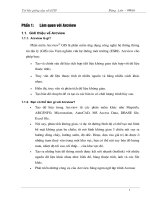Tài liệu giảng dạy CCNA - module 01 chapter 03 - Data Link Layer Fundamentals
Bạn đang xem bản rút gọn của tài liệu. Xem và tải ngay bản đầy đủ của tài liệu tại đây (354.69 KB, 22 trang )
1
Module 01
InterNetwork Overview
Chapter 03
Data Link Layer Fundamentals: Ethernet LANs
2
Table of Content
1 Typical LAN Features for OSI Layer 1
2 Typical LAN Features for OSI Layer 2
3 Early Ethernet Standards
4 Recent Ethernet Standards
3
1. Typical LAN Features for OSI
Layer 1
The OSI physical layer, or Layer 1, defines the
details of how to move data from one device to
another.
The OSI physical layer defines the standards used
to send and receive bits across a physical
network.
4
2. Typical LAN Features for OSI
Layer 2
5
Data Link Function 1: Arbitration
The specifications for these data-link protocols
define how to arbitrate the use of the physical
medium to avoid collisions, or at least to recover
from the collisions when they occur.
Ethernet uses the carrier sense multiple access
with collision detection (CSMA/CD) algorithm for
arbitration.
6
CSMA/CD
The CSMA/CD algorithm works like this:
1. A device with a frame to send listens until
the Ethernet is not busy.
2. When the Ethernet is not busy, the sender
begins sending the frame.
3. The sender listens to make sure that no
collision occurred.
4. Once the senders hear the collision, they
each send a jamming signal, to ensure that all
stations recognize the collision.
5. After the jamming is complete, each sender
randomizes a timer and waits that long.
6. When each timer expires, the process starts
over with Step 1.
7
Data Link Function 2: Addressing
Every computer has a unique way of identifying
itself : MAC address or physical address.
The physical address is located on the Network
Interface Card (NIC).
MAC addresses have no structure, and are
considered flat address spaces. MAC addresses
are sometimes referred to as burned-in
addresses (BIAs) because they are burned into
read-only memory (ROM) and are copied into
random-access memory (RAM) when the NIC
initializes.
0000.0c12.3456 or 00-00-0c-12-34-56.
8
MAC address format
The first six hexadecimal
digits, which are administered
by the IEEE, identify the
manufacturer or vendor.
The remaining six
hexadecimal digits comprise
the interface serial number.
9
Using MAC addresses
A DData A DData A DDataA DData
Source Address
Destination Address
1
0
Data Link Function 3: Error Detection
Most data-link protocols include a frame check
sequence (FCS) or cyclical redundancy check
(CRC) field in the data-link trailer. This field
contains a value that is the result of a
mathematical formula applied to the data in the
frame.
Error detection does not imply recovery. The FCS
allows the receiving device to notice that errors
occurred and then discard the data frame.
1
1
Data Link Function 4: Identifying the
Encapsulated Data
1
2
3. Early Ethernet Standards
1
3
10BASE2 and 10BASE5
Standard Topology Medium Maximum
cable
length
Transport
10BASE5 Bus Thick
coaxial
cable
500m Half-duplex
10BASE2 Bus Thin coaxial
cable
185m Half-duplex
1
4
A Repeater
Standards guarantee minimum bandwidth and
operability by specifying the maximum number of
stations per segment, maximum segment length,
maximum number of repeaters between stations,
etc.
Stations separated by repeaters are within the
same collision domain. Stations separated by
bridges or routers are in different collision
domains.
1
5
10BASE-T Ethernet
Topology: star (hub)
Medium: CAT3 UTP.
Maximum cable length: 100m.
Transport: half-duplex.
1
6
Ethernet 10BASE-T Cabling
Pin 1 Pin 1
Pin 2 Pin 2
Pin 3 Pin 3
Pin 4 Pin 4
Pin 5 Pin 5
Pin 6 Pin 6
Pin 7 Pin 7
Pin 8 Pin 8
Pin 1 Pin 3
Pin 2 Pin 6
Pin 3 Pin 1
Pin 4 Pin 4
Pin 5 Pin 5
Pin 6 Pin 2
Pin 7 Pin 7
Pin 8 Pin 8
Straight-through cable Crossover cable
1
7
10BASE-T Hubs
The hub repeats the
signal to all other
devices.
1
8
Reducing Collisions Through LAN
Switching
Switches do not create a single shared bus, like
a hub.
Switch treat each individual physical port as a
separate bus.
Switches use memory buffers to hold incoming
frames as well.
LAN switches with only one device cabled to
each port of the switch allow the use of full-
duplex operation.
1
9
4. Recent Ethernet Standards
2
0
Fast Ethernet
Two of the key features of Fast Ethernet,
as compared to 10-Mbps Ethernet, are
higher bandwidth and autonegotiation.
Medium: CAT5 UTP, fibre optic.
Transport: half or full-duplex.
2
1
Gigabit Ethernet
The most important similarity is that the
same Ethernet headers and trailers are
used, regardless of whether it’s 10 Mbps,
100 Mbps, or 1000 Mbps.
Gigabit Ethernet differs from the slower
Ethernet specifications in how it encodes
the signals onto the cable.
2
2
Summary
OSI Layer 2 Functions Ethernet Implementation
Arbitration CSMA/CD algorithm.
Addressing 6-bytes-long MAC address.
Error detection FCS in Ethernet trailer
Identifying the type of packet
inside the frame
Protocol Type
(2 bytes)—DIX Ethernet
DSAP (1 byte)—IEEE 802.2
SNAP Protocol Type (2 bytes)—
IEEE 802.2 with SNAP header









